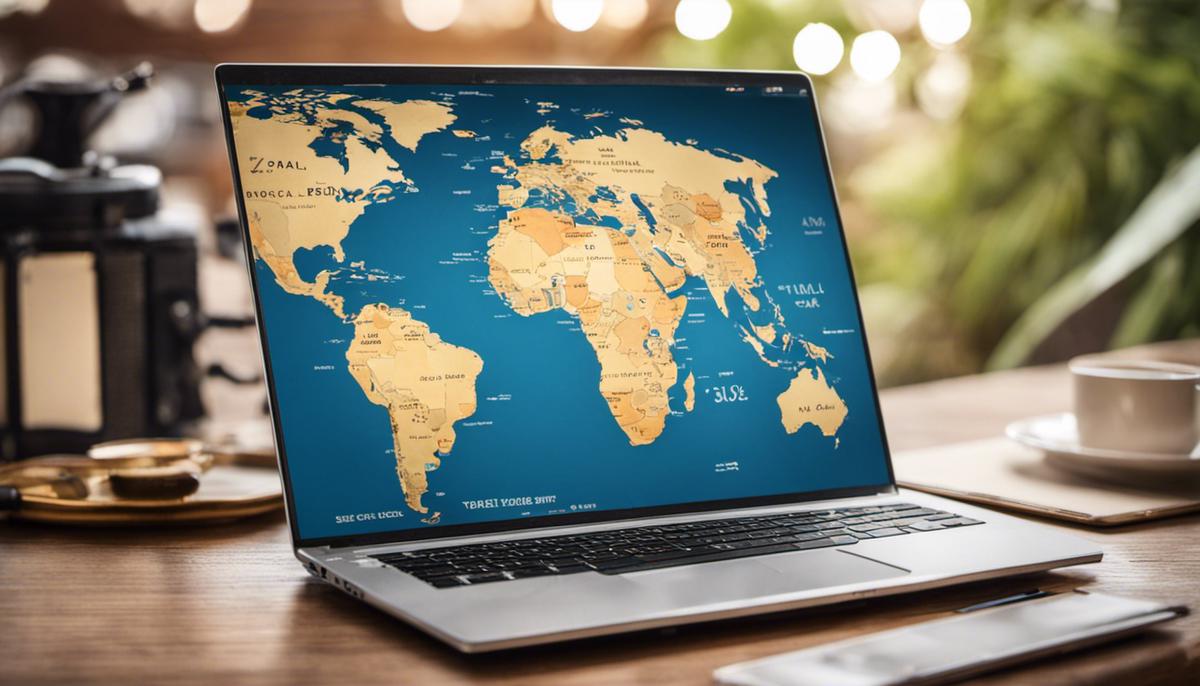BetterYouJourney.com is a participant in the Amazon Services LLC Some of the links in our posts are affiliate links. Click here to see full Disclosure.
Decoding the world of travel blogging and unraveling the secrets to making money online, this guide takes an in-depth look into what it takes to become a successful travel blogger in the digital era. What goes beyond just creating content and sharing it to an online audience? How does one leverage the power of blogging to monetize their travels, creating the life that they always dreamt of? In this extensive guide, we’re exploring these questions and much more. You’ll discover fundamental principles of blogging, lucrative ways to monetize your blog, effective strategies to promote your blog, and insightful tips on maintaining the sustainability of your blog and scaling it up to higher heights of success.
Understanding the Basics of Blogging
Understanding the Basics of Blogging
Understanding the basics of blogging is the first step towards making money as a travel blogger. Blogging can be defined as publishing engaging content online on a regular or semi-regular basis. The ultimate goal is to build a vast community of readers who love and trust the content being put forth.
Choosing a Niche for Travel Blogging
The selection of a niche is a key decision in the blogging journey. This means narrowing down the topic, in this case, travel, to a more specific area of focus. For example, your travel blog could cater to budget-conscious adventurers, luxury travelers, solo female travelers, or family vacationers. Choosing a niche would entail conducting some market research to understand the demand and interest in the topics and destinations being considered.
Creating Compelling Content
The content for your travel blog needs to be compelling and authentic. This includes a beautiful mix of photographs, narratives, and travel guides. Your blog should tell a story, provide value, and excite the reader’s curiosity. The quality of blog content plays a major role in attracting and retaining readers, through whom every blog’s monetization potential is realized.
Understanding the Target Audience
Identifying the target audience and tailoring your content to meet their interests and preferences is a necessity for any successful travel blog. Deep knowledge of the audience helps create personalized and appealing content that resonates with the reader. Over time, an engaged and loyal audience can directly and indirectly bring in income through various channels.
The Relevance of Search Engine Optimization (SEO)
Search Engine Optimization (SEO) plays a crucial role in travel blogging. Well-optimized content improves blog visibility on search engines, thus driving organic traffic. Understanding and employing the best SEO practices, such as using relevant keywords and optimizing meta tags, images, and URLs can significantly increase blog traffic thereby increasing its revenue potential.
Knowing Affiliate Marketing, Sponsored Content, Collaborations, and Advertisements
There are several ways travel bloggers can monetize their blogs online. One way is through affiliate marketing, which involves promoting a product or service on your blog and earning a commission for each sale made through your referral link.
Sponsored content is another option, where a brand pays you to write a post about their product or service. Similarly, collaborations involve partnering with another entity to create and promote content together.
Advertisements provide another income stream for blogs. You can monetize your blog traffic by showing ads from various ad networks. The revenue comes from the advertisers who pay to show their ads to your blog visitors.
Embarking on a Successful Travel Blogging Journey
The road to creating a profitable travel blog is a marathon, not a sprint. But, with a firm grasp on the fundamental principles, along with a sprinkle of determination and patience, it’s definitely achievable to transform your love for travel into a successful online business.

Monetizing the Blog
Profiting from Affiliate Marketing
For travel bloggers, affiliate marketing is considered as a sizeable source of online income. It involves endorsing products or services of different brands and companies. Every time a sale is made through the affiliate link shared on your blog, you receive a commission. Well-known affiliate marketing platforms ideal for travel bloggers are Amazon Associate, Booking.com, and Skyscanner. To capitalize on these platforms, it’s crucial to thoroughly understand their terms and conditions. Additionally, make sure the products or services are a good fit with your travel blog’s content.
Paid Collaborations and Partnerships
Often, brands are willing to pay for exposure to a particular audience, and that’s where paid collaborations come into play. They can range from creating sponsored posts, writing reviews, to creating extended content packages as an “ambassador” of sorts. There’s considerable earning potential here, but it’s dependent on the blogger’s reach and engagement rates. Identifying profitable partnerships and securing deals involves market study, calculating your blog’s value, creating persuasive pitches, and negotiation skills.
Sponsored Content – A Viable Option
Another popular method of monetizing travel blogs is through sponsored content where brands pay bloggers to write posts about their products or services, including their experiences. These can be lucrative, particularly if the blogger’s audience aligns with the brand’s target demographic. While this can offer substantial income, maintaining transparency with readers and ensuring that content does not become overly commercialized is crucial. A positive e-reputation can be damaged if readers feel misled, so clearly labeling sponsored content and maintaining a balance of independent content is advised.
Monetization Through Direct Advertisements
Direct advertising involves selling ad space on the blog to advertisers. This might be banner ads, text links, or sponsored posts. Google AdSense, Ezoic, Media.net are some platforms that can be leveraged by travel bloggers. The revenue is generally generated on a pay-per-click (PPC) or cost-per-thousand (CPM) impressions basis, but specific deals can be brokered too. Direct advertisement can be a steady source of income, but it requires a large amount of web traffic to be truly effective.
Every method of monetizing a travel blog comes with its unique conditions, income potential, and possible disadvantages. It’s critical to grasp these details to design an effective means of revenue generation. Moreover, as a well-known influencer, being transparent about your earnings strategies can foster trust with your audience. This trust is a fundamental pillar for any successful online presence.

Marketing and Promoting the Blog
Leveraging Social Media to Promote Your Travel Blog
Social media promotion is one of the most reliable techniques for promoting a travel blog. By sharing new post links, captivating travel shots, and interacting with followers, travel bloggers can nurture a blog-centric community. Platforms like Instagram, Facebook, Twitter, and Pinterest serve as conduits, reaching large audiences swiftly and driving them back to the blog. Appropriate use of travel-related hashtags can amplify your reach on these platforms.
The Power of Email Marketing
An email subscription list offers a direct line of communication with readers, giving the opportunity to share exclusive content, notify of new posts, and create a more personal experience. Tools like MailChimp and ConvertKit can help manage email campaigns, ensuring the right message reaches the right people at the right time. Additionally, offering incentives such as a free travel guide or exclusive travel tips can encourage signups to the email list.
Collaborating with Other Travel Bloggers
Collaborating with other travel bloggers can help expand the audience reach and bring fresh perspectives to the blog. Guest posting on other blogs, interviewing fellow travel bloggers, or compiling a list of the best travel blogs to follow are all effective methods of collaboration. These partnerships can also lead to beneficial networking opportunities within the travel blogging community.
Search Engine Optimization (SEO)
SEO is crucial for increasing the visibility of a travel blog in search engine results. This can involve optimizing the blog’s content and design to make it more ‘crawlable’ by search engines, using the right keywords in blog posts, ensuring fast load times, and including internal and external links in posts. Analyzing competitors using SEO tools can also provide great insights on how to improve SEO practices.
Key Metrics and Key Performance Indicators (KPIs)
Keeping track of certain metrics and KPIs can provide insightful data on the blog’s growth and performance. Examples of such metrics include number of page views, average session duration, and bounce rate. These figures allow bloggers to understand what content resonates with their audience, and adjust their strategy accordingly. Google Analytics is a commonly used tool for tracking these metrics.
Embarking on a journey as a successful travel blogger and generating income online doesn’t happen overnight. It necessitates a consistent commitment to crafting top-tier content, strategically using social media, building collaborations, harnessing the power of email marketing, and consistently updating your SEO knowledge. It’s also key to track the right analytics and Key Performance Indicators (KPIs) to accurately assess your blog’s progress. This way, you can make data-driven decisions on how to adjust your content creation and marketing approaches for optimal outcomes.

Maintaining Sustainability and Scaling Up
Establishing a Consistent Rhythm in Travel Blogging
Travel blogging presents an enticing opportunity to both share your globe-trotting adventures and insights with an international audience and earn money online. Yet, staying consistent can be tricky, given the rapid evolution of digital space. Keeping your blog updated becomes essential to remain relevant and consistently attract traffic. Publishing high-quality content that offers your readers fresh insight about an array of places, handy travel advice, and glimpses into your personal exploits stimulates reader engagement.
Implementing a content calendar can be a game-changer in achieving consistency. Monitoring various factors like holidays, prime travel seasons, and unique local events can inform your content strategy, ensuring you always have engaging, timely content to offer. Regularly interacting with your audience by responding to their feedback or queries further maintains the vitality of your blog and imparts a personalized vibe, reinforcing your connection with your followers.
Planning Strategies as a Travel Blogger
When it comes to staying relevant in the fast-paced world of digital media, having a concrete plan is essential. Travel bloggers must always be aware of current trends, popular destinations, and the type of content that resonates with their audience. This could involve investing in online courses on digital marketing or search engine optimization, networking at travel industry events, or gathering feedback from your audience. This knowledge will allow you to optimize your blog’s content to align with the preferences of your readers and the latest trends in travel.
Additionally, incorporating a variety of mediums such as images, videos, and interactive content can create a more engaging experience for your audience. With the rise of social media, linking your blog to platform-specific content can help increase engagement and reach a broader audience.
Different Ways to Expand a Travel Blog
After establishing your travel blog and gaining a steady readership, you might consider scaling your operations. This could take several different forms – expanding into new niches, collaborating with bigger brands, or even building a team to contribute to the blog.
Expanding into new niches could involve branching out to cover other aspects of travel that your blog hasn’t touched on yet. This could be anything from food and culture of various destinations, to adventure sport travel, or even travel gear reviews.
Collaborating with bigger brands can help your blog reach a larger audience and also increase its credibility. This could involve partnering with travel agencies, tourist boards, hotels or airlines for sponsored content. However, it’s essential to maintain authenticity when partnering with brands, as this can affect your blog’s trust factor amongst your followers.
Building a Team to Help Scale Your Travel Blog
Scaling up your operations might also involve hiring a team to perform tasks such as content creation, social media management, and responding to emails and comments. Outsourcing these tasks allows you to focus on strategic planning and networking, ultimately helping your travel blog grow more efficiently.
Finally, always remember that making money online as a travel blogger is a continuous process and requires perseverance. While these steps and strategies can help you maintain sustainability and scale up, it’s essential to continually adapt and innovate in the ever-evolving landscape of digital media.

Travel blogging, indeed, is not just about sharing your journey with the world; it can become a reliable source of income if executed efficiently. With this guide, we hope to have given you comprehensive insights into how you can turn your passion into profits. We’ve unveiled the crucial role of understanding the basics of blogging, learning ways to monetize it, strategies for marketing and promotion, and maintaining its sustainability and scaling up. Armed with this toolkit of knowledge, you are now poised to venture into the exciting world of travel blogging, converting your adventures into a tangible component of your financial landscape. Embrace the journey, for every step is but a beginning of a new story to tell.








